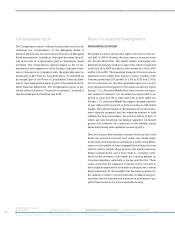Siemens 2009 Annual Report Download - page 203
Download and view the complete annual report
Please find page 203 of the 2009 Siemens annual report below. You can navigate through the pages in the report by either clicking on the pages listed below, or by using the keyword search tool below to find specific information within the annual report.
115
Managing Board statements, Independent auditors’ report, Additional information
95 Net assets position 97 Report on post-balance sheet date events
98 Risk report
108 Information required pursuant to
§315 (4) HGB of the German Commercial
Code and explanatory report
114 Compensation report
114 Report on expected developments
The value-added manufacturing sector, in which Siemens
largely operates, collapsed in all our reporting regions in 2009,
especially in our two strongest revenue-generating regions,
Europe, C.I.S., Africa, Middle East and the Americas. IHS Global
Insight estimates a decline of more than 9% in 2009, yet it fore-
sees growth of 4.2% in 2010 followed by likely growth of 5.4%
in 2011. In both years, growth in value-added manufacturing is
expected to be driven by dynamic development in the Asia,
Australia region.
The plunge in investment activity witnessed in 2009 also con-
tinues to restrict growth. IHS Global Insight expects gross
fixed investments, which accounts for a large share of gross
domestic product and is significant for Siemens as a supplier of
plant and infrastructure, to rise by 3.9% worldwide in 2010, fol-
lowing a decline of 6.4% in 2009. Even an increase of this mag-
nitude will still leave gross fixed investments in 2010 slightly
below 2007 levels. The differences between regions will be
even more pronounced on this measure than for gross domes-
tic product. According to IHS Global Insight, gross fixed invest-
ments in 2010 will rise by 9.5% in the Asia, Australia region and
3.0% in the Americas region but fall by 0.8% in the Europe, CIS,
Africa and Middle East region, which is where we generate the
majority of our revenue. The forecast for 2011 predicts growth
in global gross fixed investments of 5.7%. This time the Europe,
C.I.S., Africa and Middle East region should also see some
growth, albeit it a modest 2.8%. The Americas region is ex-
pected to see much stronger growth of around 9% in 2011 as a
result, in large part, of a surge in activity in the USA. IHS Global
Insight anticipates that gross fixed investments will increase
by 6.2% in the Asia, Australia region in 2011.
The forecasts presented above for gross domestic product and
gross fixed investments are based upon a report prepared by
IHS Global Insight dated October 14, 2009, and the data for
value-added manufacturing are based upon a report prepared
by IHS Global Insight dated November 2009. This information
has not been independently verified by Siemens. The uncer-
tainties mentioned above make it difficult to produce a reliable
forecast for expected developments at Siemens in fiscal 2010
and, in particular, for fiscal 2011.
MARKET DEVELOPMENT
Due to the severe recession, most markets served by the
Industry Sector bottomed out during fiscal 2009, and those
that did not are likely to do so during the first half of fiscal
2010. Within the Sector, we anticipate a continued decline in
markets served by Industry Automation in early 2010, though
significantly less drastic than during fiscal 2009. The Division’s
markets with longer business cycles are likely to be the most
affected, whereas a slight recovery is possible for the short-cy-
cle markets, even in the next quarters. The markets served by
Drive Technologies are tending to develop in a similar way to
those served by Industry Automation, but with a foreseeable
time lag. These markets are therefore expected to continue to
contract, especially in the early part of fiscal 2010. We antici-
pated that this will involve the Americas region in particular,
but also Europe, C.I.S., Africa and Middle East. Building Tech-
nologies serves markets in which the business cycle typically
runs behind overall economic development, and market vol-
ume is therefore expected to decline slightly in fiscal 2010.
Here too, the decline will be largely the result of slowing in the
Americas and in Europe, C.I.S., Africa and Middle East. The
lighting solutions market in which OSRAM operates is ex-
pected to recover fairly quickly from the effects of the reces-
sion, such that it will grow in fiscal 2010 compared with fiscal
2009. The business cycle in markets served by Industry Solu-
tions runs slightly behind economic development as a whole;
this applies especially for supplies to the steel industry. It is
therefore expected that these markets will continue to shrink
slightly in fiscal 2010. For the worldwide transportation mar-
kets served by Mobility a continued growth is expected in the
coming fiscal year, albeit growth might be below the rate of
2009.
Following a clear decline in the markets served by the Energy
Sector in fiscal 2009, signs of renewed growth are considered
possible during the second half of fiscal 2010 at the earliest.
Significant for this development is growth in global energy de-
mand, infrastructure development in emerging economies,
the need for investment in replacement technologies in the
developed world and increased environmental awareness gen-
erally. The market for the fossil power generation business,
which was slowing in fiscal 2009, could start to recover toward
























